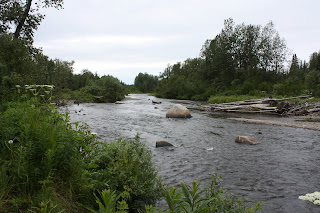July 29, 2011
At 9:30 we boarded the Valdez Spirit for a 9 hour boat cruise in the deep water (up to 800') fjord of the Prince William Sound. There are over 2,700 miles of coastline. The Captain shared history and stores as we cruised the majestic waters of Prince William Sound from Valdez to Meares Glacier. On our way out of Port Valdez we saw commercial fishing dropping their nets for salmon.
There are transfer boats, including the Northwestern seen on the TV show "Deadliest Catch", taking on fish from the smaller boats.
The Captain pointed out the location of many glaciers. Did you know that 5% of Alaska is covered by glacial ice? We saw Seal Island that was used for fox farming from 1894 to 1959. Foxes don't like water so there was no worry they would leave the island but it seemed like a long way to travel to manage a fox farm. He spoke of the 1989 Exxon-Valdez oil spill noting that the area is recovering but will not recover completely in our life times. He covered early explorers, gold and copper mining, the 1964 earthquake, oil shipping and Alaska natives of the area.
We travelled the shorelines while the Captain and two spotters looked for critters. We spotted cormorants, puffins, bald eagles,murres, kittiwakes, and oystercatchers. We saw Stellar sea lions, a black bear, sea otters,Dall's porpoises and harbor seals.

We saw Glacier Island and blue ice chunks floating in the water.

 We later got withing a quarter mile of the face of the Meares Glacier. Everyone on board was blown away when the glacier calved a huge chunk of ice into the water below. We heard the sound of it seconds later, almost like a gunshot. As we left, we could still hear that glacier groaning and creaking. We were all excited when a large wave was created by the falling chunk that had the seals, sunning on ice chunks, surfing toward our boat.
We later got withing a quarter mile of the face of the Meares Glacier. Everyone on board was blown away when the glacier calved a huge chunk of ice into the water below. We heard the sound of it seconds later, almost like a gunshot. As we left, we could still hear that glacier groaning and creaking. We were all excited when a large wave was created by the falling chunk that had the seals, sunning on ice chunks, surfing toward our boat. 
 Just when we thought it couldn't get any better, we spotted a pod of Orcas. There were about 7-9 of these "killer whales", actually members of the dolphin family. The Captain thought there were 2 new additions to the pod and he pointed out Splash, the large male Orca, travelling behind the group of playful youngsters.
Just when we thought it couldn't get any better, we spotted a pod of Orcas. There were about 7-9 of these "killer whales", actually members of the dolphin family. The Captain thought there were 2 new additions to the pod and he pointed out Splash, the large male Orca, travelling behind the group of playful youngsters. It was a long day as we travelled about 165 miles. We were all tired by the time we disembarked at 7:30 p.m. It was a full day Everyone was tired but we had seen many of the birds and mammals that inhabit Prince William Sound.
But we weren't finished yet. We took a ride to Dayville Drive and stopped to see a big bear on the side of the road. It was walking to the creek. We stopped on the bridge over the creek and I got out to snap a picture of it. The adrenaline was flowing as I got my photo and then I realized the creek wasn't that wide and bears can run uphill very fast. I walked to the car, trying not to look like prey if I started running, determined to keep my promise to NOT TO GET EATEN BY A BEAR IN ALASKA!

A few miles further down the road is the Solomon Gulch Hatchery where we were able to watch salmon as they returned to spawn. It was established to ensure that sufficient numbers of salmon return and reproduce each year. People there were actually cheering for the fish as they jumped through the salmon ladder to the other side. There were hundreds of salmon gasping for breath, covered by their brothers and sisters, as they were so tired from their swim from ocean to this creek.













































